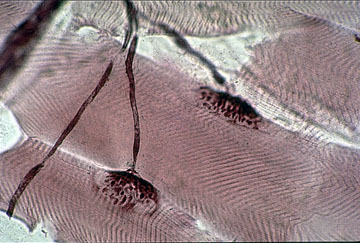
ANATOMY AND PHYSIOLOGY: SKELETAL MUSCLE AND MOVEMENT
I Muscle Tissue
A. Characteristics
1. excitability
2. contractility
B. Types
1. cardiac
2. smooth
3. skeletal
II Skeletal Muscle
A. Functions
1. locomotion
2. manipulation
3. posture
4. generate heat
B. Excitability
1. neuromuscular junction
a. axon terminal
b. acetylcholine (ACh)
c. motor end plate

2. muscle atrophy
C. Contractility
1. structure
a. muscle fiber appearance
1. sarcolemma
2. multinucleate
3. striated
b. internal structures
1. myofibrils
2. sarcomere
3. myofilaments
a. myosin, thick
b. actin, thin
c. Z-line
2. Sliding Filament Theory of Contraction

III Skeletal Muscle (organ)
A. Muscle fiber organization
1. muscle fibers ---> fascicles ---> whole muscle
B. Connective tissue organization
1. endomysium
a. blood vessels and nerves
2. perimysium
3. epimysium
4. tendon
C. Contraction of whole muscle
1. �all or none� principle
2. strength of contraction
a. number of fibers
3. fatigue
4. muscle tone
IV Movement
A. Requirements
B. Muscle attachments
1. origin
2. insertion
C. Muscle roles
1. agonist
2. antagonist
3. synergist

D. Rotator Cuff
V Exercise
A. aerobic
1. increased endurance
B. resistance or isometric (vs. isotonic)
1. increased muscle size
a. cause of increased size
When you finish this unit, you should be able to:
- explain the basic characteristics of all muscle tissue
- define acetylcholine, motor end plate, neuromuscular junction
- draw a neuromuscular junction and explain the sequence of events occurring there
- explain how a skeletal muscle fiber knows when to contract
- draw the structure of a skeletal muscle fiber labeling myofibril, sarcomere, myofilament, actin, myosin, A-band, I-band, Z-line
- explain HOW a single muscle fiber manages to shorten its length.
- explain the "Sliding Filament Theory of Contraction"
- describe the structure of a whole skeletal muscle (the organ) including the connective tissue wrappings
- list the steps between exciting a muscle fiber and the muscle moving a bone
- explain how one muscle can perform different strengths of contraction
- list the causes of muscle fatigue
- describe what is happening inside a muscle when it is �toned�
- describe the roles (agonist, antagonist, synergist) of muscles
- give an example of one muscle which can perform different roles
- use the rotator cuff muscles to demonstrate the relationship between a muscle origin, insertion, and action
- compare aerobic exercise and isometric contraction
return to A&P outlines
return to A&P
return to homepage
Last Updated: 4/1/24